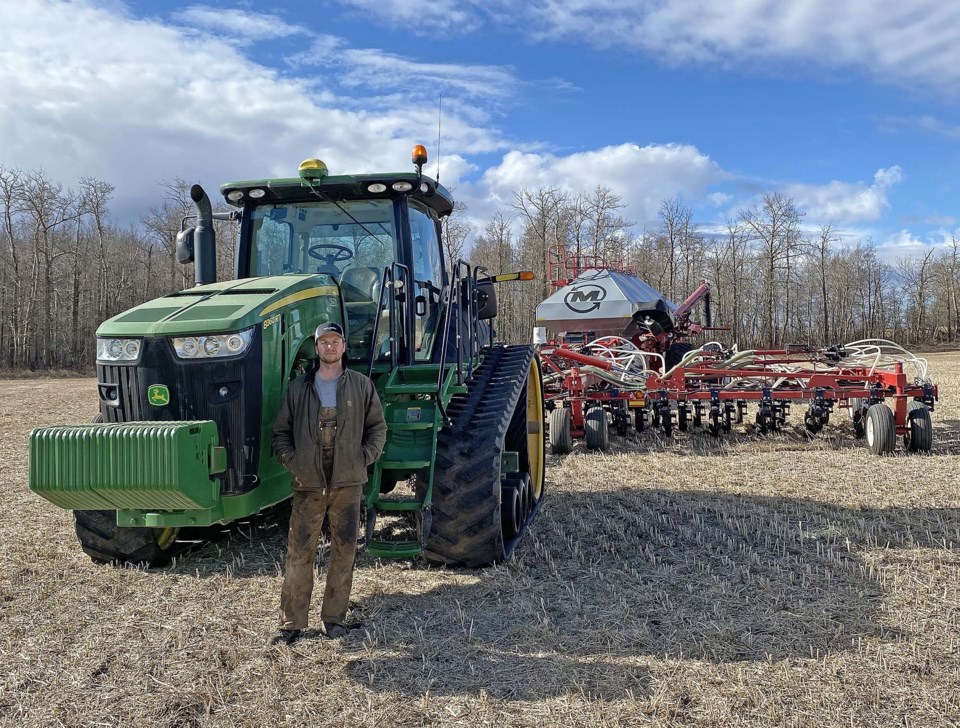Sturgeon County farmers have started planting this year’s crops almost a month early to take advantage of warm, dry conditions.
May 1 has historically been the start of spring seeding in Sturgeon County, although the actual start swings a week or two to either side, based on weather conditions.
This year, several Sturgeon County farmers had their seeders going on April 8, said Craig Solberg, assistant branch manager with Sturgeon Valley Fertilizers.
“It’s the earliest [start] in this geography people can recall,” he said, and a week ahead of the earliest start he’s seen in his 40 years in the farm sector in Alberta.
“There is no ‘normal’ anymore.”
Solberg said the top eight inches of dirt in the county have been pretty dry all winter, and there wasn’t a lot frost in the soil. That let some farmers get an early start on this region’s oft-too-short growing season.
Jeff Nonay of Lakeside Dairy between Legal and Bon Accord was one of these early seeders, having started on his hard red wheat on April 11. About 630 acres of his crops were actually planted last fall in the form of winter wheat (which you plant in the fall and harvest in the summer).
While this was an early start, Nonay said it was much easier to plant early nowadays because of no-till agriculture, which requires only an inch or so of thawed soil to deposit seeds. It’s also really dry out, and planting early maximizes your chances to capture any spring rains — or snows, such as the snow that fell on Wednesday, April 17.
Solberg said last Wednesday’s snows mean that most farmers will hold off on seeding until in around April 24, with seeding in full swing by May 1.
Nonay said Wednesday’s snows shouldn’t be a problem for his crops and that he planned to start planting his peas and barley by the April 20 weekend once the weather warmed up again.
Drought ahead?
Nonay said his fields have enough moisture to get his crops going, but are otherwise extremely dry, and will need heavy rains in May to carry those crops to the finish.
“We’re going to need water a lot quicker than other years, for sure.”
Last winter was super dry, with a huge swath of Alberta between Athabasca and High Level getting less snow than it had in about 50 years, said Ralph Wright, manager of the Alberta Climate Information Service. That’s a big deal, as this region gets about 35 per cent of its annual moisture from snowpack. Southern Alberta is in the midst of a multi-year water deficit, which is of major concern for irrigators, while snows in the last three months have provided dryland farmers with some hope.
Sturgeon County got low to extremely low amounts of precipitation last winter, and its soil moisture reserves for pasture were at one in six- to 12-year lows as of April 3, provincial data shows. Wright said crops are in a moisture deficit right out of the gate and will need moisture soon.
It's tough to say if Alberta will have a drought this summer, Wright said. Assuming we get a La Niña climatic pattern (which typically follows El Niño, which is what we had last winter), we should have colder, wetter weather this summer. Environment Canada (as of March 31) had predicted a 50-to-60 per cent chance of above-normal heat in central Alberta between now and June, but did not make any firm predictions for precipitation for that period.
“No one’s ever lost a crop in winter,” Wright said, adding that May rains would determine the fate of this year’s crops.
Visit agriculture.alberta.ca/acis for the latest crop weather information.




